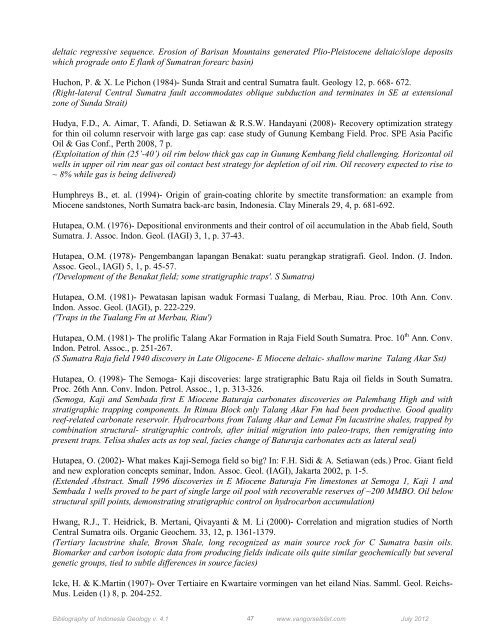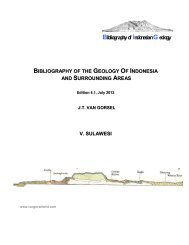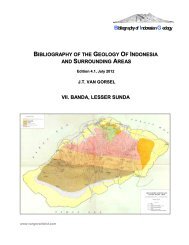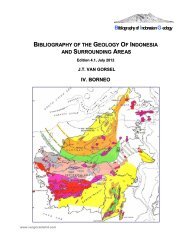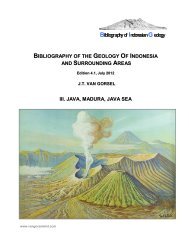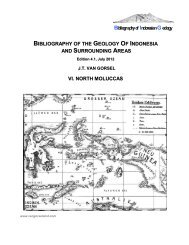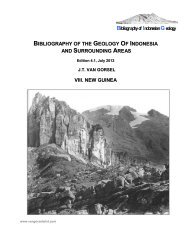Sumatra, Sunda Shelf, Natuna - Bibliography of Indonesia Geology
Sumatra, Sunda Shelf, Natuna - Bibliography of Indonesia Geology
Sumatra, Sunda Shelf, Natuna - Bibliography of Indonesia Geology
Create successful ePaper yourself
Turn your PDF publications into a flip-book with our unique Google optimized e-Paper software.
deltaic regressive sequence. Erosion <strong>of</strong> Barisan Mountains generated Plio-Pleistocene deltaic/slope deposits<br />
which prograde onto E flank <strong>of</strong> <strong>Sumatra</strong>n forearc basin)<br />
Huchon, P. & X. Le Pichon (1984)- <strong>Sunda</strong> Strait and central <strong>Sumatra</strong> fault. <strong>Geology</strong> 12, p. 668- 672.<br />
(Right-lateral Central <strong>Sumatra</strong> fault accommodates oblique subduction and terminates in SE at extensional<br />
zone <strong>of</strong> <strong>Sunda</strong> Strait)<br />
Hudya, F.D., A. Aimar, T. Afandi, D. Setiawan & R.S.W. Handayani (2008)- Recovery optimization strategy<br />
for thin oil column reservoir with large gas cap: case study <strong>of</strong> Gunung Kembang Field. Proc. SPE Asia Pacific<br />
Oil & Gas Conf., Perth 2008, 7 p.<br />
(Exploitation <strong>of</strong> thin (25’-40’) oil rim below thick gas cap in Gunung Kembang field challenging. Horizontal oil<br />
wells in upper oil rim near gas oil contact best strategy for depletion <strong>of</strong> oil rim. Oil recovery expected to rise to<br />
~ 8% while gas is being delivered)<br />
Humphreys B., et. al. (1994)- Origin <strong>of</strong> grain-coating chlorite by smectite transformation: an example from<br />
Miocene sandstones, North <strong>Sumatra</strong> back-arc basin, <strong>Indonesia</strong>. Clay Minerals 29, 4, p. 681-692.<br />
Hutapea, O.M. (1976)- Depositional environments and their control <strong>of</strong> oil accumulation in the Abab field, South<br />
<strong>Sumatra</strong>. J. Assoc. Indon. Geol. (IAGI) 3, 1, p. 37-43.<br />
Hutapea, O.M. (1978)- Pengembangan lapangan Benakat: suatu perangkap stratigrafi. Geol. Indon. (J. Indon.<br />
Assoc. Geol., IAGI) 5, 1, p. 45-57.<br />
('Development <strong>of</strong> the Benakat field; some stratigraphic traps'. S <strong>Sumatra</strong>)<br />
Hutapea, O.M. (1981)- Pewatasan lapisan waduk Formasi Tualang, di Merbau, Riau. Proc. 10th Ann. Conv.<br />
Indon. Assoc. Geol. (IAGI), p. 222-229.<br />
('Traps in the Tualang Fm at Merbau, Riau')<br />
Hutapea, O.M. (1981)- The prolific Talang Akar Formation in Raja Field South <strong>Sumatra</strong>. Proc. 10 th Ann. Conv.<br />
Indon. Petrol. Assoc., p. 251-267.<br />
(S <strong>Sumatra</strong> Raja field 1940 discovery in Late Oligocene- E Miocene deltaic- shallow marine Talang Akar Sst)<br />
Hutapea, O. (1998)- The Semoga- Kaji discoveries: large stratigraphic Batu Raja oil fields in South <strong>Sumatra</strong>.<br />
Proc. 26th Ann. Conv. Indon. Petrol. Assoc., 1, p. 313-326.<br />
(Semoga, Kaji and Sembada first E Miocene Baturaja carbonates discoveries on Palembang High and with<br />
stratigraphic trapping components. In Rimau Block only Talang Akar Fm had been productive. Good quality<br />
reef-related carbonate reservoir. Hydrocarbons from Talang Akar and Lemat Fm lacustrine shales, trapped by<br />
combination structural- stratigraphic controls, after initial migration into paleo-traps, then remigrating into<br />
present traps. Telisa shales acts as top seal, facies change <strong>of</strong> Baturaja carbonates acts as lateral seal)<br />
Hutapea, O. (2002)- What makes Kaji-Semoga field so big? In: F.H. Sidi & A. Setiawan (eds.) Proc. Giant field<br />
and new exploration concepts seminar, Indon. Assoc. Geol. (IAGI), Jakarta 2002, p. 1-5.<br />
(Extended Abstract. Small 1996 discoveries in E Miocene Baturaja Fm limestones at Semoga 1, Kaji 1 and<br />
Sembada 1 wells proved to be part <strong>of</strong> single large oil pool with recoverable reserves <strong>of</strong> ~200 MMBO. Oil below<br />
structural spill points, demonstrating stratigraphic control on hydrocarbon accumulation)<br />
Hwang, R.J., T. Heidrick, B. Mertani, Qivayanti & M. Li (2000)- Correlation and migration studies <strong>of</strong> North<br />
Central <strong>Sumatra</strong> oils. Organic Geochem. 33, 12, p. 1361-1379.<br />
(Tertiary lacustrine shale, Brown Shale, long recognized as main source rock for C <strong>Sumatra</strong> basin oils.<br />
Biomarker and carbon isotopic data from producing fields indicate oils quite similar geochemically but several<br />
genetic groups, tied to subtle differences in source facies)<br />
Icke, H. & K.Martin (1907)- Over Tertiaire en Kwartaire vormingen van het eiland Nias. Samml. Geol. Reichs-<br />
Mus. Leiden (1) 8, p. 204-252.<br />
<strong>Bibliography</strong> <strong>of</strong> <strong>Indonesia</strong> <strong>Geology</strong> v. 4.1 47 www.vangorselslist.com July 2012


